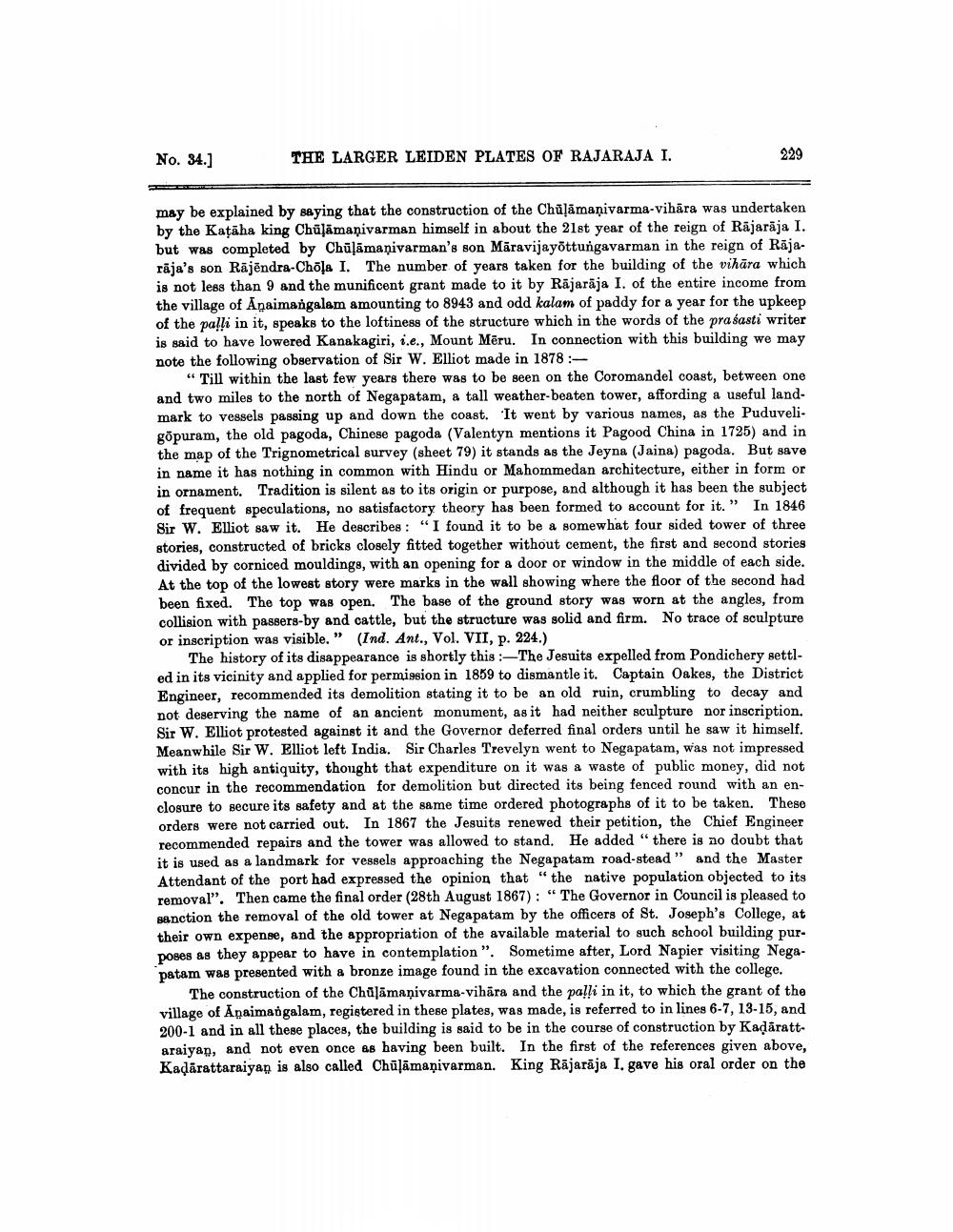________________
No. 34.]
THE LARGER LEIDEN PLATES OF RAJARAJA I.
229
may be explained by saying that the construction of the Chūļāmaņivarma-vihāra was undertaken by the Kaţāha king Chūļāmaņivarman himself in about the 21st year of the reign of Rājarāja I. but was completed by Chūļāmaņivarman's son Māravijayottungavarman in the reign of Rājaraja's son Rājēndra-Chöja I. The number of years taken for the building of the vihāra which is not less than 9 and the munificent grant made to it by Rājarāja I. of the entire income from the village of Anaimangalam amounting to 8943 and odd kalam of paddy for a year for the upkeep of the palli in it, speaks to the loftiness of the structure which in the words of the praśasti writer is said to have lowered Kanakagiri, i.e., Mount Mēru. In connection with this building we may note the following observation of Sir W. Elliot made in 1878
“Till within the last few years there was to be seen on the Coromandel coast, between one and two miles to the north of Negapatam, a tall weather-beaten tower, affording a useful landmark to vessels passing up and down the coast. It went by various names, as the Puduveligopuram, the old pagoda, Chinese pagoda (Valentyn mentions it Pagood China in 1725) and in the map of the Trignometrical survey (sheet 79) it stands as the Jeyna (Jaina) pagoda. But save in name it has nothing in common with Hindu or Mahommedan architecture, either in form or in ornament. Tradition is silent as to its origin or purpose, and although it has been the subject of frequent speculations, no satisfactory theory has been formed to account for it.” In 1846 Sir W. Elliot saw it. He describes : "I found it to be a somewhat four sided tower of three stories, constructed of bricks closely fitted together without cement, the first and second stories divided by corniced mouldings, with an opening for a door or window in the middle of each side. At the top of the lowest story were marks in the wall showing where the floor of the second had been fixed. The top was open. The base of the ground story was worn at the angles, from collision with passers-by and cattle, but the structure was solid and firm. No trace of sculpture or inscription was visible." (Ind. Ant., Vol. VII, p. 224.)
The history of its disappearance is shortly this - The Jesuits expelled from Pondichery settled in its vicinity and applied for permission in 1859 to dismantle it. Captain Oakes, the District Engineer, recommended its demolition stating it to be an old ruin, crumbling to decay and not deserving the name of an ancient monument, as it had neither sculpture nor inscription. Sir W. Elliot protested against it and the Governor deferred final orders until he saw it himself. Meanwhile Sir W. Elliot left India. Sir Charles Trevelyn went to Negapatam, was not impressed with its high antiquity, thought that expenditure on it was a waste of public money, did not concur in the recommendation for demolition but directed its being fenced round with an enclosure to secure its safety and at the same time ordered photographs of it to be taken. These orders were not carried out. In 1867 the Jesuits renewed their petition, the Chief Engineer recommended repairs and the tower was allowed to stand. He added "there is no doubt that it is used as a landmark for vessels approaching the Negapatam road-stead" and the Master Attendant of the port had expressed the opinion that "the native population objected to its removal". Then came the final order (28th August 1867): “The Governor in Council is pleased to sanction the removal of the old tower at Negapatam by the officers of St. Joseph's College, at their own expense, and the appropriation of the available material to such school building purposes as they appear to have in contemplation". Sometime after, Lord Napier visiting Negapatam was presented with a bronze image found in the excavation connected with the college.
The construction of the Chūlāmanivarma-vihāra and the palli in it, to which the grant of the village of Anaimangalam, registered in these plates, was made, is referred to in lines 6-7, 13-15, and 200-1 and in all these places, the building is said to be in the course of construction by Kadarattaraiyan, and not even once as having been built. In the first of the references given above, Kadārattaraiyan is also called Chūļāmaņivarman. King Rājarāja I. gave his oral order on the




